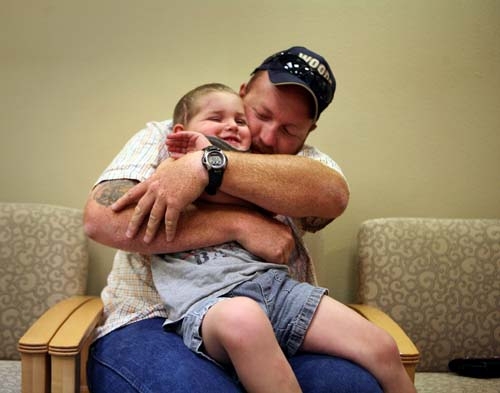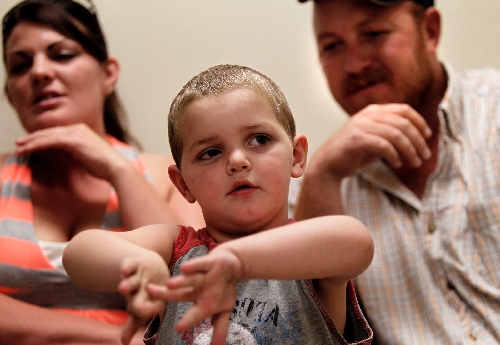Unsecured TVs endanger thousands of kids
Little Cash Adams decided he wanted to fix the flickering TV on top of the dresser.
So the 3-year-old, who had finished treatments for cancer only a few days earlier, pulled out drawers in the dresser to make a ladder.
As he started to climb, his weight pulled the dresser and television on top of him.
When his mother discovered him minutes later, Cash wasn't moving and his eyes had rolled back in his head.
"Cash, Cash," Christy Adams screamed, picking her son up and heading outside.
The frantic mother ran down the street with her little boy in her arms.
"Somebody please help me," she cried. "Please help me."
After Cash arrived at University Medical Center's Pediatric Trauma Center on July 27, what doctors found on scans of his head was frightening.
He had multiple skull fractures -- so many, in fact, that doctors said his head reminded them of what happens when someone cracks a hard-boiled egg.
It was the 10th time in less than five years that surgeons at UMC would work to save the life of a child whose insides were caved in by a TV and the furniture it rested on.
Three little ones died from their injuries. Three other toddlers suffered permanent brain damage, while the others seem to be doing well. Time will tell whether Cash, who was released from the hospital after about a month in critical care, will fully recover.
On Tuesday, Dr. Deborah Kuhls, a trauma surgeon, and Dr. Meena P. Vohra, head of pediatric critical care medicine at UMC, looked again at Cash's scans from the summer.
"It's amazing that he survived," Kuhls said, grimacing at an image of a bone fragment slicing into Cash's brain.
"When people are child-proofing their homes, they need to secure TVs and entertainment units to the wall," the doctor said. "This isn't just a problem here; it's all across the nation."
A GROWING PROBLEM
A 2009 study in the journal Clinical Pediatrics detailed the growing problem of unstable furniture and televisions falling on children. Almost 17,000 children who suffered such accidents were rushed to emergency rooms in 2007, the last year when complete figures were available. That's up 41 percent since 1990. Most of the children were under age 6.
Researchers linked the increased accidents to the popularity of ever-bigger flat-panel TVs and the narrow, unstable entertainment centers used to hold them. Almost half the injuries were associated with falling TVs. The TV that Cash pulled down on him was an older 37-inch model. And the dresser was the kind found in most bedrooms.
Arlene Flecha, a spokeswoman for the U.S. Consumer Product Safety Commission, said TVs and the furniture they rest on often have a high center of gravity, making them particularly unstable.
The U.S. Consumer Product Safety Commission recommends that TVs and the furniture they rest on be anchored.
Most of the injuries associated with falling TVs and furniture were bumps and bruises common to childhood; but 3 percent of the 264,200 children whose cases were studied since 1990 had to be admitted to the hospital, most for head and neck injuries.
Three hundred children died.
In 2005 and 2007, legislation was introduced in Congress that would have mandated safety straps and anchor mechanisms for televisions. Both measures died in committee.
As Vohra saw yet another scan where Cash's skull had separated, she shook her head.
"People need to realize the dangers of having these large TVs at home," she said. "I have had children come here who have been hurt by TVs placed on the cardboard box in which it came."
She said other accidents occurred after TVs had been on storage crates and unsecured entertainment centers.
"I had another one recently where the toddler was lying on the floor and kicking the base of the TV, so it toppled on his stomach and he had severe injury to his liver," she said. "These are totally preventable accidents."
As she thought about what had happened in July, Christy Adams urged other parents to secure their furniture and TVs.
"The stress of all this is very difficult," she said. "Nobody should want this to happen in their family. This isn't the kind of story you want to tell anybody.
"I'm basically a nervous wreck, but I don't have time for a breakdown because of my kids."
TRAUMA TEAM AT WORK
Cash's injury wasn't the first tribulation for the family from Enterprise, Utah, 160 miles northeast of Las Vegas. Christy Adams' brother died six years ago. The year after that, her infant daughter died.
And then doctors thought Cash, who had just turned 2, had an enlarged spleen. It turned out to be a tumor the size of a cantaloupe growing out of his left kidney and wrapping around his stomach.
The cancer and the kidney were removed during a six-hour operation in Salt Lake City. Cash had just finished radiation and chemotherapy treatments before the accident that almost killed him.
On that afternoon, Cash and his 2-year-old sister Shyann were watching a kids' movie on TV. Christy Adams stepped outside for a moment to call her husband, Tyler, a trucker who was on the road. She heard something and ran inside, finding her nearly lifeless son on the floor next to the TV.
"Shyann either pushed the TV off his head or it bounced off," she said. "I was just gone for a minute and something so terrible happened."
As she ran down the street carrying Cash, she noticed that he was crying but couldn't open his blackened eyes. Fluid -- later determined to be the result of his brain injury -- was leaking from his nose and ears.
Adams wasn't surprised when the mayor showed up to answer the 9-1-1 call.
"It's a small town and everybody knows everybody," she said of Enterprise, a town with less than 2,000 residents that has a gas station grocery and a hardware store.
An ambulance took Cash and his mother to a hospital in St. George, Utah.
After doctors did some brain scans and inserted a breathing tube, Cash was flown by helicopter to UMC, the only designated pediatric trauma center in the area.
A trauma team at UMC placed Cash in a medically induced coma, deliberately lowering the child's temperature to around 95 degrees to relieve intracranial pressure. They drilled a hole in Cash's head to insert a sensor, a device that would indicate how badly his brain was swelling.
"They told me the first 72 hours after the accident would determine whether he made it," Christy Adams said.
About a week after Cash arrived at UMC, Dr. William Smith, a neurosurgeon, and Dr. John Menezes, a plastic surgeon, did six hours of reconstructive surgery. There were more than 20 fractures in the skull and at least another seven in the face. Bones had to be moved back into alignment.
What the surgeons did was akin to trying to put a shattered porcelain dish back together with epoxy. Smith recalled how carefully he had to place tiny metal plates into Cash's skull, securing them with screws.
"I'd say there were over a 100 screws to bring the skull back together in correct anatomic fashion," he said. "Ten years ago he probably wouldn't have made it. Technological advances played a large role in keeping him alive."
THE FOLLOW-UP EXAM
On Thursday afternoon, Cash and his parents show up for a follow-up visit with Smith.
Cash wears a neck brace, and the scars on his head are clearly visible through his closely cropped brown hair. He spends much of his time in the waiting room chatting with people waiting to see a doctor.
"I'm going to be a football player," the youngster tells a woman. "I'm going to be a quarterback."
Tyler Adams hugs his son.
"I'm surprised he made it," he says. "He's got so much energy. He just wants the neck brace taken off."
In the examination room, the neurosurgeon asks Cash to jump.
He does, landing loudly on both feet. He jumps again. And again.
"Wow, " Smith says, "just like Michael Jordan.
Smith seems moved by how well Cash is doing.
"This is so encouraging," he says, stressing that the fear of seizures doctors had for Cash because of his brain injuries lessens each day. "Our big fear of seizures was during the first few weeks after the accident."
Cash tells Smith he doesn't like wearing the neck brace.
"You don't have to wear it any more," the surgeon says. "You're doing great."
Cash's dad takes the brace off his son, and the boy runs over to a waste basket and stuffs it in.
Contact reporter Paul Harasim at pharasim@reviewjournal.com or 702-387-2908.


















